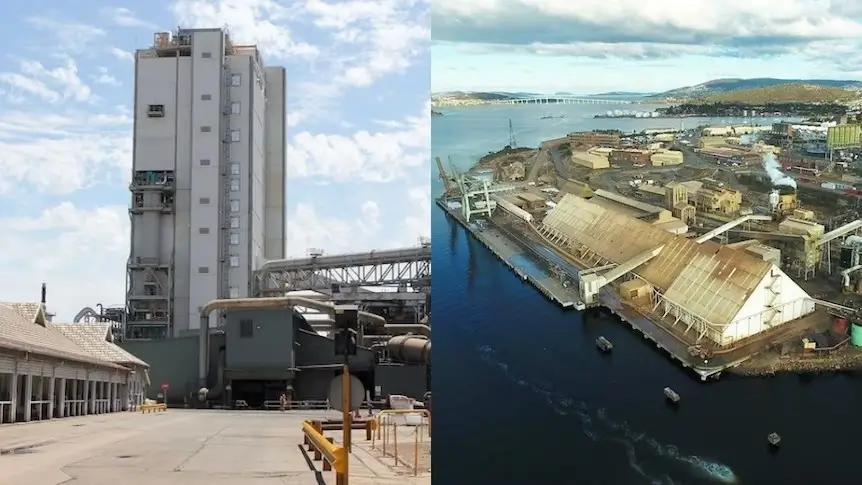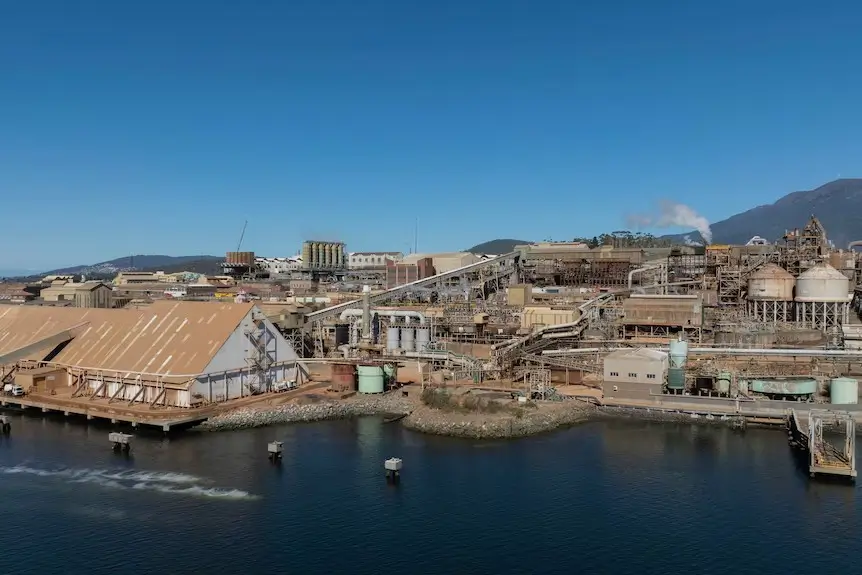
Source: ABC News: Glen Moret, left photo
The federal government, Tasmania and South Australia dominated the headlines today with the announcement of a A$135 million bailout package to support Nyrstar’s Port Pirie lead smelters and Hobart zinc smelters. It’s timely news: both factories had threatened to operate at a loss, unable to compete with subsidised foreign rivals.
Of note is how this move redirects Australian industry—not in response, but by intention—bridging industrial policy, jobs security and security of our nation for the first time in our critical minerals agenda.
Eight Takeaways Immediately
Bailout plus more: Governments are not only saving jobs—they’re redirecting infrastructure to critical minerals production: antimony, bismuth, germanium, indium.
Port Pirie will be the sole producer of antimony in Australia—if the proposed pilot plant proves successful, it will provide a sovereign supply of metal only a few nations currently make.
Rare bipartisan and whole-of-government accord, Canberra, Adelaide, and Hobart all supporting—revealing consensus on maintaining industrial capacity.
Saviour of local economy: Around 1,350 jobs are guaranteed, plus extra local contract work for more than 600 employees.
Loss of national assets: These are generations of metallurgical expertise—losing them would be like wiping out generations of training and engineering capability.
China is a structural risk: These were pushed to destruction by China’s subsidies for steel and antimony treatment—skewing global treatment charges to near zero, rendering local refining uncompetitive.
New agenda for Critical Minerals: Governments are experimenting with price floors and extended-term offtake contracts to secure future production—experimenting with a new industrial policy toolkit.
Beyond base metals: This’s not about zinc or lead—it’s about high-technology value chains and clean-energy industries depending on these downstream capabilities.
A New Perspective: Smelters as Strategic Infrastructure, Not Heritage Assets

Source: ABC News: Glen Moret, left photo
Most of the coverage describes it as a regional lifeline. But the larger change is geopolitical: having these germanium, antimony, and indium processes in Australia means that frontier minerals are kept in local hands, not foreign. It’s not unrealistic about factory jobs—it’s a realization that industrial competence is sovereignty.
If Port Pirie becomes Australia’s only antimony producer, it would mean we hold critical control over a metal used in defence electronics, flame‑resistant materials and battery technologies. With the additional freshwater zinc capacity being built in Tasmania, it provides a new location on the world’s minerals map.
Lives, Regions and Rural Pulse
In Port Pirie and North-West Tasmania, they are the backbone of towns whose identity and existence hinge on them. One shop owner spoke of the sense of relief: “It’s not only about income. Its structure—the town stays on the map when the plant keeps running.” In both towns, local groups have based local holidays and cultural events around smelter birthdays.
Worker families speak of multi-generational labor: grandfathers, fathers and grandchildren all laboring in the same furnaces. This save is about saving those lines—and the towns constructed around them.
Also Read: Endeavour Mine Revival: Regional NSW Enters New Era of Production
Why the Funding Now—Not Earlier
Nyrstar had pleaded plaintively mid-year, threatening that Port Pirie was hemorrhaging “tens of millions a month.” Conveyor belts at the plant continued to roll, but storm clouds were brewing. Political complacency was eventually overcome by desperation. That desperation—read in Canberra—transferred a possible catastrophe into a managed transition.
The National Strategy Now Emerging
Behind the headlines is a developing industrial strategy. Price floors on key minerals, offtake contracts, and co-investment by the industry are the way forward. Australia now sees such refineries—once thought to be legacy export hubs—as strategic capability centers.
This may be a template for lithium, vanadium, rare earths and other emerging materials that need local value‑add, not raw export.
What to Watch Out For: Looking Ahead
Pilot Plant Outcomes: Will Port Pirie be able to accelerate production of antimony in months rather than years?
Hobart Study Findings: Will germanium or indium be commercially viable—or niche by-products?
Policy Development: Will Canberra expand price mechanisms for rare minerals to base metals?
China Global Disruption of Supply: How will China react to Australia increasing resilience in these industries?
Private-Public Models: Is this setting a national standard for other strategic but troubled assets—such as Mount Isa or Pilbara copper?
Wider Industry Trends We Can’t Avoid
Glencore’s recent appeals for assistance to keep copper smelters running in Queensland suggest an expanding horizon: Australia can be the first free-trade nation pushed towards industrial subsidiarity. If international smelting economics continue shifting, we might witness growing numbers of plants labeled “strategic infrastructure” eligible for government anchoring.
Final Word: An Industrial Turnabout
The A$135 million Australian rescue of Port Pirie and Hobart smelters is not a sticking plaster. It is the beginning of a national critical metals strategy. And from here on, the narrative is simple: we do not merely want to extract metals from the earth—but to process, engineer and mastermind them here.
This is political courage. It’s national strategy. And it’s generational: a single act of preservation—or transformation—that could define Australia’s industrial footprint for decades.

